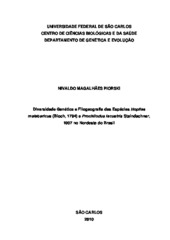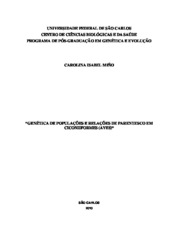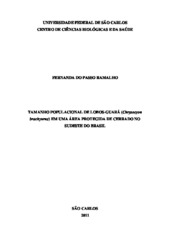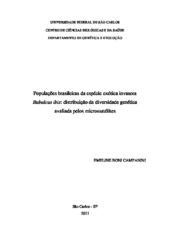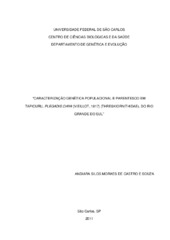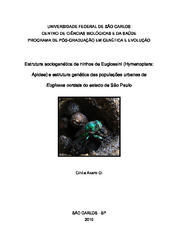Search
Now showing items 1-10 of 15
Estruturação genética populacional de Salminus hilarii (Characiformes : Characidae) na Bacia do Alto Paraná
(Universidade Federal de São Carlos, 2015-08-13)
The Salminus genus is characterized by predatory fish medium to large, migratory and
ichthyophagi, very appreciated in fisheries and gastronomy. Among these stands out the
Salminus hilarii species, popularly known as ...
História natural, biogeografia e a genética de populações de Partamona rustica, uma abelha endêmica de florestas secas do Brasil
(Universidade Federal de São Carlos, 2016-04-29)
Partamona rustica is a stingless bee endemic to dry forests in Brazil. Despite its
importance as a pollinator and its occurrence in endangered areas, such as the Caatinga
(scrubland forest) and Cerrado (savanna) biomes, ...
Diversidade genética e filogeografia das espécies Hoplias malabaricus (Bloch, 1794) e Prochilodus lacustris Steindachner, 1907 no Nordeste do Brasil
(Universidade Federal de São Carlos, 2010-05-21)
The State of Maranhão is considered as a transitional area between northeastern semiarid and amazonian rainforest. Various perennial rivers such as the rivers Parnaíba, Itapecuru, Mearim, Pindaré and Gurupi are found in ...
Genética de populações e relações de parentesco em Ciconiiformes (Aves)
(Universidade Federal de São Carlos, 2010-08-06)
Population genetic parameters and genetic relatedness estimates were carried out for Roseate Spoonbill (Platalea ajaja), Wood Stork (Mycteria americana) and Great Egret (Ardea alba egretta) reproductive colonies in Amapa, ...
Tamanho populacional de lobos-guará (Chrysocyon brachyurus) em uma área protegida de cerrado no sudeste do Brasil
(Universidade Federal de São Carlos, 2011-03-30)
The Maned Wolf (Chrysocyon brachyurus) is listed among the threatened extinction species in Brazil due to loss of its natural habitat to agriculture and frequent roadkill. Aiming to determinate the population size of C. ...
Populações brasileiras da espécie exótica invasora Bubulcus ibis: distribuição da diversidade genética avaliada pelos microssatélites
(Universidade Federal de São Carlos, 2011-08-19)
The Cattle Egret (Bubulcus ibis) is a median sized bird, of African origin, considered as an invasive and exotic species in the American continent. In Brazil, first record was in the north, in 1964. The species have been ...
Caracterização genética populacional e parentesco em Tapicuru, Plegadis chihi (Vieillot, 1817) (Threskiornithidae), do Rio Grande do Sul
(Universidade Federal de São Carlos, 2011-01-24)
The white-faced ibis, Plegadis chihi (Vieillot, 1817) (Pelecaniformes, Threskiornithidae) is a migratory waterbird that breeds in colonies in the southern of Brazil. In point of view of genetics, this species was not ...
Estrutura sociogenética de ninhos de Euglossini (Hymenoptera: Apidae) e estrutura genética das populações urbanas de Euglossa cordata do estado de São Paulo
(Universidade Federal de São Carlos, 2010-08-26)
Euglossine bees (Hymenoptera: Apidae) are important pollinators in the Neotropical region. These bees are widely studied by collecting males in attractive baits, but there are few reports from females. In this work, we ...
Comportamento reprodutivo de espécies de Trypargilum e análises de parentesco genético intranidal e genética de populações de Trypoxylon (Trypargilum) albitarse (Hymenoptera: Crabronidae)
(Universidade Federal de São Carlos, 2013-08-23)
The genus Trypoxylon consists of solitary wasps that build mud nests or nest in preexisting cavities, which brood cells positioned linearly are stored with paralyzed spiders. The male in species of the subgenus Trypargilum ...
Garça-vaqueira (Bulbucus ibis): a diversidade genética no estudo do comportamento reprodutivo e na caracterização da população invasora brasileira
(Universidade Federal de São Carlos, 2013-03-05)
The genetic diversity of the cattle egret (Bubulcus ibis) was analyzed to investigate reproductive behavior and characterize Brazilian populations of the species. Genotypes at seven microsatellite loci were used to investigate ...


